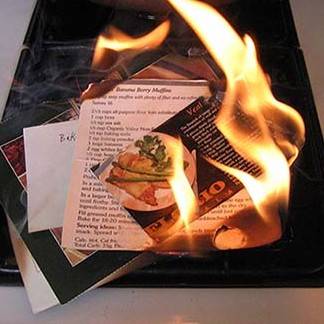 “I can’t make this, because I don’t have (fill in the blank).”
“I can’t make this, because I don’t have (fill in the blank).”
When was it that we went from a culture that could fend for ourselves on the prairie to one that needed to slavishly follow recipes like a timid, freshman chemistry student afraid of blowing up the lab?
Granted, cooking is essentially chemistry and physics, with a good dose of art lest you confuse your dinner with that of your pet’s. But, somewhere along the line we lost our ability to grab an armload of whatever was growing in the backyard or on local farms, and turn it into a meal without simultaneously cracking open a library of cookbooks or more recently, spending half an evening searching for recipes online. Of course, this also manages to place us in endless checkout lines after work buying the single missing ingredient for the recipe d’jour.
This behavior has been enabled by grocery stores that stock produce regardless of season: rock-hard peaches in December, watery strawberries in January, and asparagus made woody by its trek from California in March. We’ve also been reinforced by several leading magazines.
As I was perusing some back issues over the weekend, I found dishes with the word spring in their name, albeit in Italian, with ingredients that are not available until the height of summer. I also found a stir-fry recipe that combined peas and red peppers. This, in a magazine with substantial gardening content whose editors should know better. Peas, including snow peas, are spring crops that would be reduced to hard, starchy pellets by the summer heat required to ripen peppers.
One would think that magazines that feature profiles of chefs who’ve made their reputations using local ingredients would not make the same mistakes, but they do. Whether homemaking or gourmet, there are huge disconnects between the editorial content of these publications and the recipes they promote.
Turning a basket of produce into a meal or several without a recipe isn’t rocket science. (I make up my own recipes for this column nearly every week based on what’s in my pantry and freezer.) However, if you grew up in a family whose meals were dictated by the latest recipe clipped from what was on the newsstand and not by what was piling up in bushel baskets from the garden, it can be intimidating.
Still, if you can master a few basic techniques for dishes like omelets, frittatas, grain pilafs, stir-fries, and soup, you will be well on your way to seasonal, local eating. An omelet that uses spinach in spring can just as easily use Swiss chard in fall. A stir-fry that uses eggplant and peppers in summer, can use carrots and fennel in fall.
So, where do you learn these techniques? Some you can pick up online. This is one of the better instructional videos for making a basic omelet. Unfortunately, there also are plenty that show bad technique or are unnecessarily complex. Similarly, there are plenty of sub-par stir-fry videos. This one is great for showing technique, but comes up short on saucing the end product. While not in video form, this is a great basic soup recipe. You can turn this into a summer soup by subbing onions for leeks, carrots for sweet potatoes, Swiss chard for kale, and chopped, fresh tomatoes for canned.
Still nervous about deviating from recipes? On April 21, Steve Moore, production manager and HACCP director for Tiny Greens in Urbana is teaching a local foods workshop at Common Ground Food Co-op. In the workshop, you can learn how to cook without recipes by using basic cooking techniques and food pairings common to Midwest produce offerings. Moore also will show you how to plan a seasonally-inspired menu and cover the best options for finding locally produced food. He’ll even give you a seasonal menu-planning guide. The class runs from 6 – 8 p.m. Advance registration and payment are required. The class costs $20 for CGFC member-owners and $40 for non-member owners.








